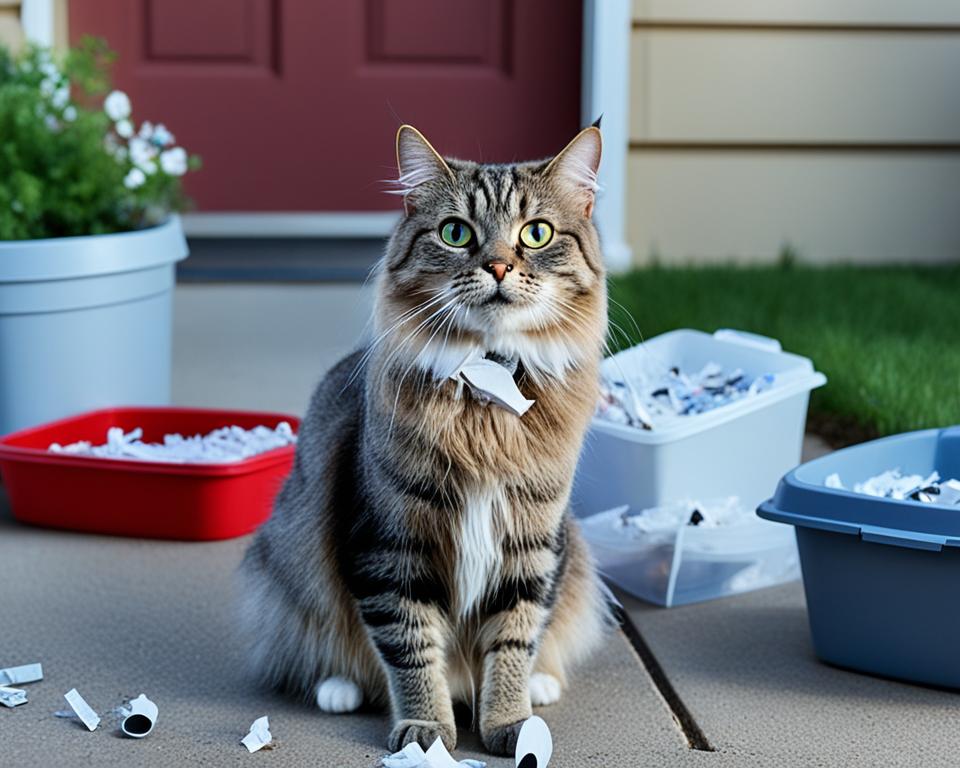As a cat owner, I’ve seen my share of feline behavior issues. Things like litter box troubles and furniture scratching can be tough. But, 77% of us have dealt with these problems too. Luckily, with the right pet care and training, we can overcome these challenges.
Understanding how cats behave is crucial to solving these problems. Each cat, like a Siamese or a kitten, is different. By learning about cat behavior, we can find solutions to make our homes peaceful for both us and our cats.
This guide will cover common cat behavior issues and how to fix them. We’ll talk about setting up the right litter box and stopping scratching furniture. We’ll look at ways to make your cat’s space better and strengthen your bond. Let’s start this journey to understand and support our cats better.
Understanding Common Cat Behavior Issues

As a cat owner, I’ve learned it’s key to spot signs of distress in our feline friends. Cats show us how they feel through their actions. Changes in behavior can mean they’re not okay.
Recognizing Signs of Distress in Cats
Cat stress shows in many ways. I’ve seen cats act differently when they’re stressed. They might avoid the litter box, groom too much, or get aggressive. Chronic licking often means they’re in pain or anxious.
The Importance of Ruling Out Medical Causes
Don’t jump to conclusions about behavior problems. Always check with a vet first. Many times, behavior issues come from health problems. For example, peeing outside the box could be a sign of a urinary infection, not just a behavior issue.
Environmental Factors Influencing Cat Behavior
Cats are very aware of their surroundings. Changes, like new pets or a change in routine, can affect them. I’ve seen that giving them things to do, like scratching posts and toys, helps keep them happy.
| Behavior Issue | Possible Cause | Solution |
|---|---|---|
| Inappropriate Elimination | Dirty litter box, Medical issues | Clean box regularly, Vet check-up |
| Excessive Vocalization | Pain, Senility in older cats | Medical evaluation, Increased attention |
| Aggression | Stress, Anxiety, Medical problems | Identify triggers, Provide safe spaces |
Learning about these common cat behavior issues has made me a better cat owner. By watching for changes and acting fast, we can help our cats be happy and healthy.
Litter Box Troubles: Causes and Solutions

Cat litter box problems are a common issue for pet owners. Knowing why cats might not use their litter boxes is key to fixing them. Let’s look at why cats might avoid their litter boxes and how to solve these problems.
Medical Reasons for Litter Box Avoidance
Before thinking it’s a behavior problem, check for medical reasons. Issues like urinary tract infections, kidney stones, and digestive problems can cause litter box avoidance. In fact, about 10% of cats have elimination problems, often because of health issues. If your cat stops using the litter box, see a vet right away.
Optimal Litter Box Setup and Maintenance
Keeping the litter box clean is key to avoiding problems. I suggest having one box per cat, plus an extra. Put them in quiet spots that are easy for cats to get to. Cats like big, uncovered boxes with shallow litter.
Clean the box every day and do a deep clean once a week with unscented products.
| Litter Box Preferences | Cat’s Ideal Setup |
|---|---|
| Box Size | 1.5 times cat’s body length |
| Litter Type | Unscented clumping, fine sand consistency |
| Box Style | Open, uncovered |
| Cleaning Frequency | Daily scooping, weekly deep clean |
Addressing Litter Preferences and Aversions
Cats can be picky about their litter. They often like the type they used as kittens. If your cat is avoiding the box, try different litters. Unscented clumping litter is usually a good choice. Avoid scented products, as they can be too strong for cats. It may take up to two weeks for a cat to get used to a new litter box setup.
“The key to resolving litter box issues is patience and understanding your cat’s preferences.”
By looking at these factors, you can fix most feline elimination issues. This will help keep a happy, healthy bond with your cat.
Scratching Furniture: Redirecting Natural Instincts

Many cat owners face the problem of furniture getting damaged by their pets. But, there are ways to stop this and save your stuff.
Cats scratch for many reasons like stretching, keeping their claws healthy, and marking their territory. This behavior starts when they are about 8 weeks old. Knowing this helps us find good ways to deal with it.
To keep your furniture safe, get strong scratching posts. Put them where your cat likes to scratch. Cats like different textures, so try sisal rope, corrugated cardboard, or carpet-covered posts. Make sure the post is tall enough for your cat to stretch fully.
- Offer variety in scratching surfaces
- Use catnip to attract cats to new posts
- Provide posts with corners for dual-side scratching
To protect your furniture, cover areas with sheets or double-sided tape. Praising your cat when they use the scratching post works great. Regular nail trimming can also lessen damage.
Don’t scold your cat for scratching. It can make them confused and stressed. Instead, give them the right places to scratch. With patience and the right steps, you can save your furniture and keep your cat happy and healthy.
Cat Behavior Problems: Solutions for Aggression
Cat aggression is a big problem for many cat owners. In fact, 27 percent of cats are given up to shelters because they are too aggressive. As a cat lover, I know how upsetting this can be. Let’s look at the different types of cat aggression, what causes it, and how we can deal with it.
Types of feline aggression
Cats can be aggressive in many ways, like during play, out of fear, or when they can’t get away. Young cats that don’t get enough social time often show play aggression. Fear aggression happens when a cat feels trapped and scared. Redirected aggression is when a cat gets upset and takes it out on people or other pets.
Identifying triggers for aggressive behavior
It’s important to know what makes your cat aggressive. Things like too much petting or fights with other cats can trigger it. Health issues like hyperthyroidism or dental problems can also make cats aggressive. By watching your cat’s body language and what happens before they get aggressive, you can figure out and handle these triggers.
Techniques for managing and reducing aggression
Reducing cat fights and managing aggression takes time and effort. Starting early is important. Give your cat lots of places to scratch and hide to stop fights over territory. Use treats to praise them when they act calm. Never punish an aggressive cat because it can make them more scared and anxious. For serious problems, see a vet who specializes in animal behavior. With the right steps, we can help our cats stop being aggressive and make our homes peaceful.

